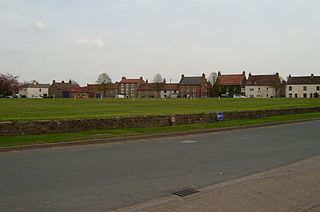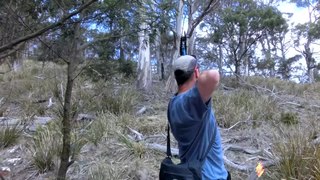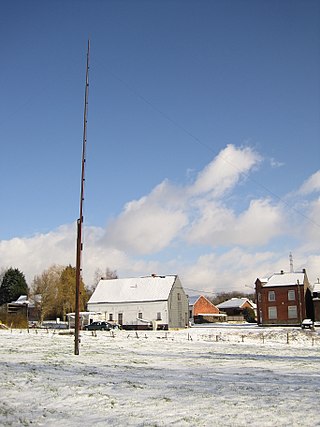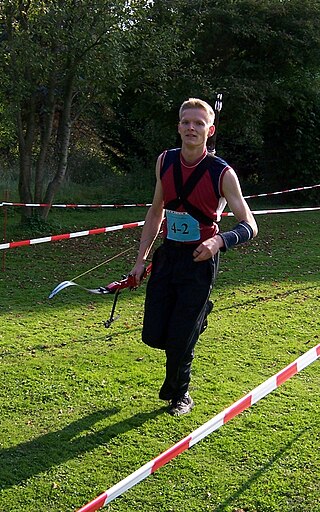Related Research Articles

Archery is the sport, practice, or skill of using a bow to shoot arrows. The word comes from the Latin arcus, meaning bow. Historically, archery has been used for hunting and combat. In modern times, it is mainly a competitive sport and recreational activity. A person who practices archery is typically called an archer, bowman, or toxophilite.

Archery at the 2004 Summer Olympics was held at Panathinaiko Stadium in Athens, Greece with ranking rounds on 12 August and regular competition held from 15 August to 21 August. One hundred twenty-eight archers from forty-three nations competed in the four gold medal events—individual and team events for men and for women—that were contested at these games.

Archery had its debut at the 1900 Summer Olympics and has been contested in 18 Olympiads. 105 nations have competed in the Olympic archery events, with France appearing the most often at 15 times. The most noticeable trend has been the excellence of South Korean archers, who have won 32 out of 44 gold medals in archery events since 1984. Olympic archery is governed by the World Archery Federation. Recurve archery is the only discipline of archery featured at the Olympic Games. Archery is also an event at the Summer Paralympics.

The Royal Company of Archers, The King's Bodyguard for Scotland, is a ceremonial unit that serves as the Sovereign's bodyguard in Scotland—a role it has performed since 1822 during the reign of King George IV when the company provided a personal bodyguard to the King on his visit to Scotland. It is currently known as the King's Bodyguard for Scotland or, more often and colloquially, The Royal Company. It is located in Edinburgh, the capital city of Scotland. The Royal Company of Archers has a long history in Scotland as a body that celebrated both the recreation and talent of local archers. As a body established by the Monarch, the company has a long history of unique prizes, influential supporters, and ceremonial roles. It has an associated charity, the Royal Company of Archers Charitable Trust, dedicated to helping disadvantaged individuals with their health and wellbeing in Scotland.

Scorton is a village and civil parish in the former Richmondshire district of North Yorkshire, England. It is approximately 8 miles (13 km) north-west of the county town of Northallerton.
Scorton Feast is an annual event held at Scorton, North Yorkshire, England. Many activities are held on the raised village green, although there are currently several other key sites including Beck Green and the Archery field, the Gymkhana/Harness Racing field off Banks Lane, and the Flower Show tent on Bolton Road.
At the 2008 Summer Olympics, the Archery competitions were held between 9 August and 15 August, at the Olympic Green Archery Field, a temporary venue on the Olympic Green, Beijing's Olympic Park.

Kiplingcotes Derby, run at Kiplingcotes in the East Riding of Yorkshire, is widely accepted to be the oldest annual horse race in the English sporting calendar. It reputedly began in 1519 and takes place on the third Thursday in March, often in exceptionally adverse weather conditions. The 500th race took place on 21 March 2019.

Target archery is the most popular form of archery, in which members shoot at stationary circular targets at varying distances. All types of bow – longbow, barebow, recurve and compound – can be used. In Great Britain, imperial rounds, measured in yards, are still used for many tournaments and these have slightly different rules to metric (WA) rounds, which are used internationally. Archers are divided into seniors and juniors, with juniors being those under the age of 21.

Field archery is any archery discipline that involves shooting at outdoor targets of varying and often unmarked distance, typically in woodland and rough terrain.

Popinjay or papingo, also called pole archery, is a shooting sport that can be performed with either rifles or archery equipment. The object of popinjay is to knock artificial birds off their perches. The rifle form is a popular diversion in Denmark; a Scottish variant is also known. The archery form, called staande wip in Dutch language and papegai in French, is popular in Belgium, and in Canada among descendants of 20th-century Belgian emigrants; it is shot occasionally in the United Kingdom under the governance of the Grand National Archery Society. In Germany a traditional shooting at wooden birds placed on a high pole is called "Vogelschießen". These are carried out either with small bore rifles or crossbows.
This is a list of archery terms, including both the equipment and the practice. A brief description for each word or phrase is also included.
The Society of Archers is an English archery organisation that was formed on Sunday 14 May 1673.

The women's recurve individual archery event at the 2010 Commonwealth Games was a competition held as part of the archery programme at the Yamuna Sports Complex in Delhi, India, from 4 October to 10 October 2010. It was the second time that the recurve individual event for women had been included in the Commonwealth Games and the first time it had been contested since the 1982 Games in Brisbane, Australia.

Run archery is a shooting discipline connecting archery with running. It is similar to the sport of biathlon.
Modern competitive archery involves shooting arrows at a target for accuracy and precision from a set distance or distances. This is the most popular form of competitive archery worldwide and is called target archery. A form particularly popular in Europe, North America, and South America is field archery, shot at targets generally set at various distances in a wooded setting. There are also several other lesser-known and historical forms, as well as archery novelty games.

The girls' individual archery event at the 2014 Summer Youth Olympics was held from 22 to 25 August 2014 at the Fangshan Sports Training Base in Nanjing, China. One of three recurve archery events which comprised the archery programme, it was the second time the girls' individual discipline was contested at Summer Youth Olympics. Thirty-two archers from thirty-two countries entered the competition, which was open to female archers born between 1 January 1997 and 31 December 1999. The defending champion was South Korea's Kwak Ye-ji, who was unable to defend her title due to the age limitations imposed on the event.

The girls' individual archery event at the 2018 Summer Youth Olympics was held from 12 to 16 October 2018 at the Parque Sarmiento in Buenos Aires, Argentina. One of three recurve archery events which comprised the archery programme, it was the third time the girls' individual discipline had been contested at Summer Youth Olympics. Thirty-two archers from thirty-two countries entered the competition, which was open to female archers born between 1 January 2001 and 31 December 2003. The defending champion was China's Li Jiaman, who was unable to defend her title due to the age limitations imposed on the event.
The women's individual recurve competition at the 2019 European Games was held from 21 to 26 June 2019 at the Olympic Sports Complex in Minsk, Belarus. It was the second time the event was held as part of the European Games archery programme. A total of 48 archers from 32 different nations entered the competition, with a maximum of three entries per country. The event offered one qualifying spot for the women's individual event at the 2020 Summer Olympics for any archer reaching the semi-finals from a nation that had not already qualified. The defending champion, Karina Winter of Germany, did not take part following her retirement from the sport.
The Woodmen of the Ancient Forest of Arden are an exclusive society of longbow shooting toxophilites, founded in 1758 in the village of Meriden, in the Borough of Solihull, in the ancient Forest of Arden.
References
- ↑ Scorton Arrow
- ↑ Ascham Silver Arrow
- ↑ "Aim of the game". The Harrogate Advertiser. 23 May 2008. Retrieved 8 August 2008.
- ↑ Ancient Society of Kilwinning Archers
- ↑ The Kiplingcotes Derby